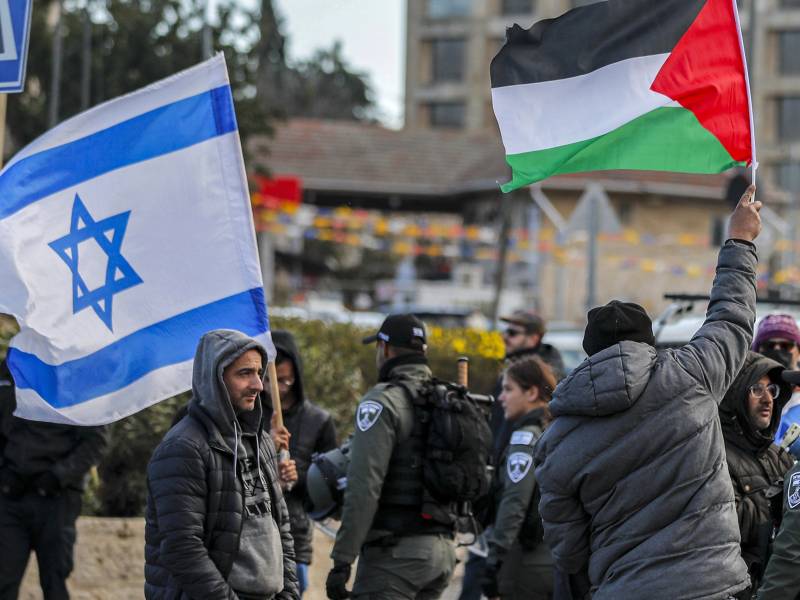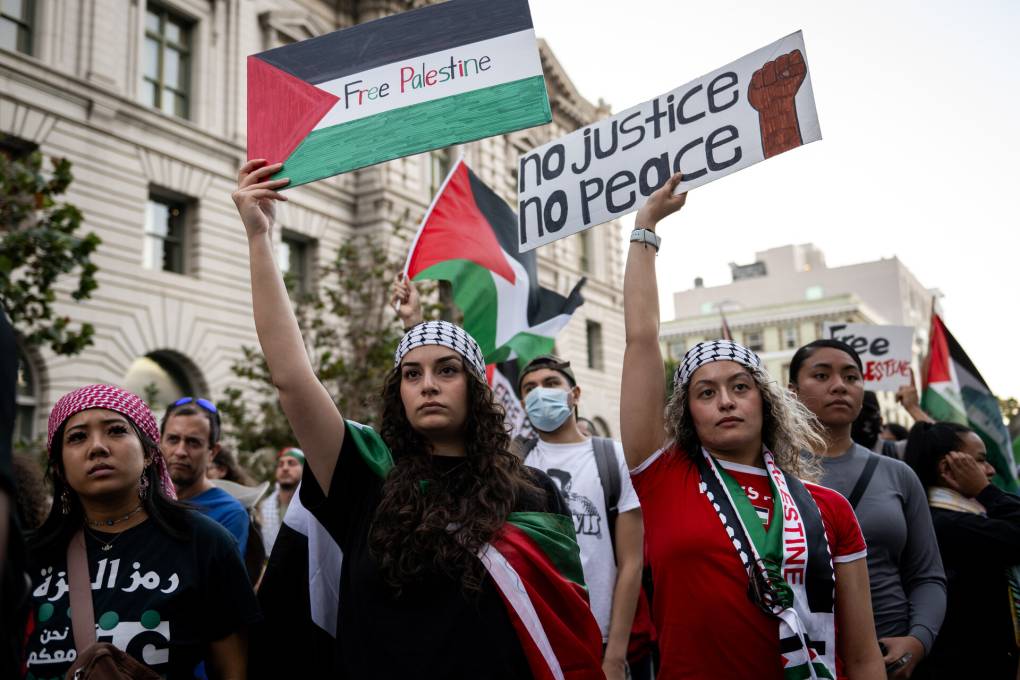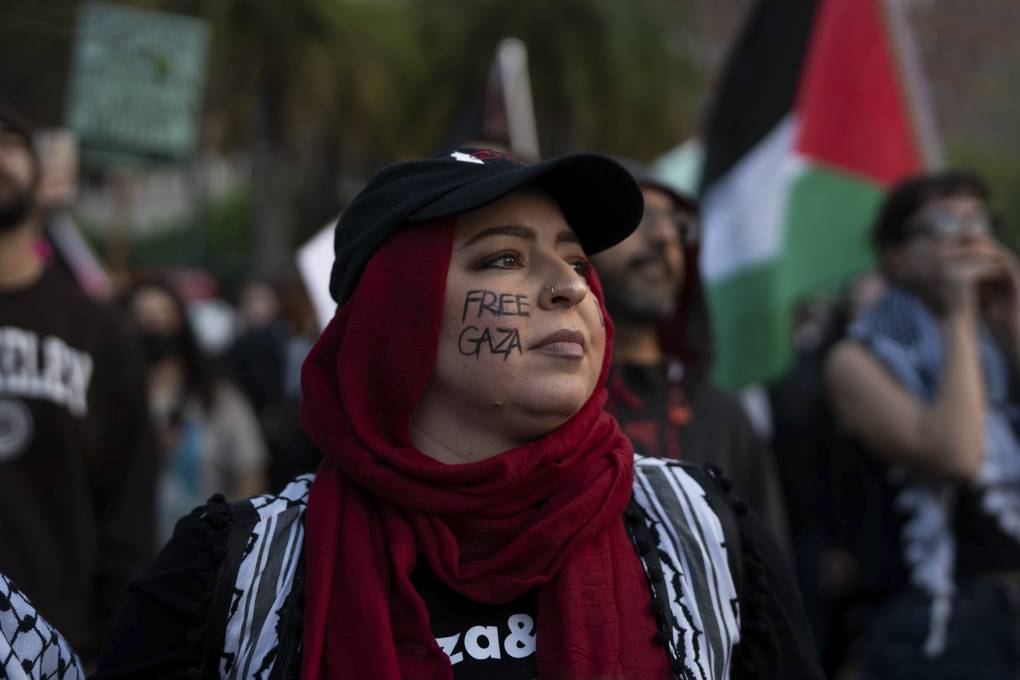Israel continues to respond to Hamas’ unprecedented attack on its people, bombarding Gaza and preparing for a ground offensive. Humanitarian groups and some foreign leaders are calling for a cease-fire. But what are the prospects for long-term peace?
Is Biden's Goal of a 2-State Solution to the Israeli-Palestinian Conflict Still Possible?

President Biden said Wednesday that there is no going back to the status quo before Oct. 7 — meaning in part that when the crisis is over, there must be a view of what comes next.
“In our view, it has to be a two-state solution,” he said, reiterating a comment he made during his visit to Israel. “And that means a concentrated effort for all the parties — Israelis, Palestinians, regional partners, global leaders — to put us on a path toward peace.”
The two-state solution calls for establishing an independent state for Palestinians alongside that of Israel. And U.S. support for it is nothing new: For decades, it has been the primary proposed framework for resolving the Israeli-Palestinian conflict.
But failed peace talks, logistical questions, expanded Israeli settlements, Palestinian attacks and recurring clashes have kept it from becoming a reality. The two-state solution has seen dwindling support from both Palestinians and Israelis over the years. And its prospects now seem dimmer than ever, in light of Hamas’ attack on Israel and Israel’s response.
Dennis Ross, who was the chief U.S. negotiator at the 2000 Camp David summit between Israeli and Palestinian leaders, told NPR that as heartbreaking as the situation is in the Middle East right now, eventually “there needs to be a day after.”
“We have to understand: Israelis aren’t going anyplace, and Palestinians aren’t going anyplace,” Ross said. “Somehow, given that, we have to find a way towards coexistence, and obviously, we’re not there now.”
Where did the two-state solution come from?
The Israeli-Palestinian conflict is long-running and complex but primarily rooted in a dispute over land with immense historical and religious significance to Jews and Muslims (as well as Christians).
Jewish proponents of the Zionist movement began moving to Ottoman Palestine — which was predominantly Arab — in the late 19th century, seeking safety from European antisemitism in their ancient homeland. Many more followed suit after the Holocaust.

Tensions grew between the two groups. Britain — which had governed Palestine since 1922 — referred the issue to the United Nations. The U.N. General Assembly voted in 1947 to divide Palestine into two states, one Jewish and one Arab.
The partition plan was rejected by the Arab community, in part due to concerns about how much land and access to resources it would get. But the plan was embraced by the Jewish community as legal justification for the establishment of Israel.
Israel declared independence in May 1948. Five Arab nations immediately invaded the new country, prompting a major Israeli offensive and many months of fighting. That resulted in the permanent displacement of thousands of Palestinians, which some refer to as the Nakba, meaning “catastrophe” in Arabic.
Another major turning point came in 1967, with Israel’s decisive victory in the Six-Day War against Egypt, Syria and Jordan.
Israel gained territory four times its original size, taking control of the Sinai Peninsula, the Golan Heights, the West Bank, the Gaza Strip and East Jerusalem.
Those territories have been a major point of contention and peace negotiations ever since. The U.N. issued a resolution in 1967 calling for Israeli troops to withdraw from areas it captured, though the resolution’s meaning has been disputed.
That set up the current occupation of the West Bank and Gaza, which are collectively home to some 5 million Palestinians. (Israel pulled troops and settlers out of Gaza in 2005, but it’s still considered an occupied territory because the withdrawal was done without any agreement and Israel still exerts control over it.)
The two-state solution was baked into Israel’s creation but didn’t necessarily play out as planned, says Jon Alterman, director of the Middle East Program at the Center for Strategic and International Studies.
“What started off in the U.N.’s mind as a 50-50 split of Mandatory Palestine, after the 1948 war — which was initiated by the Arab armies — it was more than 50 percent for Israel. After 1967, it was 100 percent-plus for Israel,” he says. “And now Israel is, I think, the only country that’s hard to draw on a map.”
Has the two-state solution ever come close to reality?
U.S. President Bill Clinton brought Palestine Liberation Organization (PLO) leader Yasser Arafat and Israeli Prime Minister Yitzhak Rabin together in 1993 to negotiate the agreement that came to be known as the Oslo Accords.
In it, Israel officially recognized the PLO as the representative of the Palestinian people and a partner in future negotiations, and the PLO renounced terrorism and recognized Israel’s right to exist.
The deal raised expectations for a two-state solution. But it quickly began to unravel after a series of events, including a 1994 attack on a mosque in Hebron by an American Jewish settler and Rabin’s assassination in 1995 by an Israeli settler opposed to the agreement.
Almost immediately after the Oslo Accords were signed, Israel enhanced its policy of fragmenting Gaza from the West Bank and East Jerusalem, says Atalia Omer, a professor of religion, conflict and peace studies at the Keough School of Global Affairs at the University of Notre Dame.
At the same time, Israeli settlements continued to proliferate in the West Bank — on occupied land that the Palestinians hoped would be part of their state.
And that has continued in the years since. The population of Israeli settlers in the occupied West Bank, including East Jerusalem, grew from 520,000 to more than 700,000 between 2012 and 2022, according to the U.N. Office of the High Commissioner for Human Rights.
“Settlements continue to eat into Palestinian spaces,” Omer says. “And over the course of the 30 years since the Oslo Accords — signed in the White House in September 1993 — the settlements completely prevented the possibility of a contiguous sovereign Palestinian state within that two-state framework.”
What are the other obstacles?
Discussions of a two-state solution center on a number of core issues, as the Council on Foreign Relations explains.
One is how exactly the borders would be drawn. Most international diplomacy favors Israel reverting to a version of its pre-1967 borders, without a consensus on how that would account for the Palestinians living within those borders or the Jewish Israelis beyond them.
Israel has annexed the whole city of Jerusalem as its capital, while Palestinians claim East Jerusalem as the capital of their state — which makes for another logistical question.
There’s also the major question of Palestinian refugees of the wars of 1948 and 1967. The survivors and their descendants live mostly in Jordan, Lebanon and Syria and claim the right to return to Israel based on a 1948 U.N. General Assembly resolution. Israel views that right to return as a threat to its existence as a Jewish state and believes those refugees should go to the Palestinian state instead.
Security looms large, too. Israel views certain Palestinian militant groups as existential threats — including Hamas, which governs Gaza and whose founding charter called for the obliteration of Israel — and wants them to disarm. Israel wants to maintain the ability to act in Palestinian areas against security threats. Palestinians want an end to Israel’s military occupation and full control over their own security.
Both sides want recognition of their respective states by the other and the international community. Palestinians also want acknowledgment of and redress for their forced displacement, Omer says.
“There needs to be a recognition and kind of naming, and then put in place mechanisms to redress — how can Palestinians be compensated for historical injustice they experienced — and then figure out ways of respecting Jewish citizens in the space through principles of equality and democracy,” Omer says.
Where did peace negotiations stand before this war?
There has been little progress since the turn of the millennium. The collapse of the 2000 peace process fueled the Second Intifada, a major Palestinian uprising in the Israel-occupied Palestinian territories and Israel.
It ended in 2005 with some 1,000 Israelis and 3,200 Palestinians dead, along with heightened skepticism of the peace process on both sides. Those feelings seem to have prevailed in the years since, which have been marked by terrorist attacks, military raids, rocket fire, border clashes and other incidents.
“As a fundamental proposition, it’s hard to have productive peace talks when no side sees either urgency or necessity to reach an agreement,” says Alterman, of the Center for Strategic and International Studies.
He says that from an Israeli perspective, security was improving, Palestinian demands were diminishing and it would be politically divisive to make concessions to them. Palestinians, meanwhile, had a sense that they couldn’t make an agreement with the right-wing government of Prime Minister Benjamin Netanyahu and that it wasn’t worth giving up rights when demographics were in their favor in the long run.
All the while, support for a two-state solution has shrunk considerably among both Israelis and Palestinians.
A Gallup poll released last week — conducted before Hamas’ attack on Israel — found that just 24% of Palestinians living in the West Bank, Gaza and East Jerusalem supported a two-state solution. That figure is down from 59% in 2012.
A Pew Research Center poll released in September found that only 35% of Israelis think “a way can be found for Israel and an independent Palestinian state to coexist peacefully,” a decline of 15 percentage points since 2013.
“A decent number of Israelis and Palestinians have come to conclude that it’s not a solution, that the nature of Israeli behavior, especially in the West Bank, makes a Palestinian state unviable,” says Alterman, noting that many members of the Israeli government want to annex the West Bank altogether.
He says it’s too early to say where the current conflict will go, though many Israelis believe Israeli politics are more likely to move to the right than the left in the wake of Hamas’ attack, which killed some 1,400 people in Israel and resulted in more than 220 hostages taken.
“When I talk to Israeli officials, I don’t get any sense that part of the strategy is providing a political horizon for Palestinians,” he added, “which is what a peace agreement would ostensibly be.”
That doesn’t mean Israeli citizens aren’t pushing for peace at all. Sally Abed is a member of Standing Together, an organization that aims to improve Arab-Jewish relations within Israel, and she’s also a Palestinian.
“I really don’t want to think that we needed to endure such loss, such atrocities here in Israel,” she told NPR. “But maybe now I really hope that from this dark corner, we can have this shift in the paradigm on how we actually look at these wars and how, actually, we look at the Israeli control over Gaza and over the West Bank, and really have a different outlook on what our leadership actually should look like.”
What are the alternatives?
There are alternatives to a two-state solution — including a one-state solution, a confederation, annexation and maintaining the status quo — at least in theory.
Rand Corp. focus groups conducted in 2018 and 2019 found that none of those was acceptable to a majority of both Israelis and Palestinians, underscoring the deep complexities and emotions involved.
Alterman says one of the biggest challenges for Israelis is balancing the need for a Jewish state and a democratic state.
“If you have a one-state solution that gives citizenship to all of the natural-born residents of Mandatory Palestine — which includes Gaza and the West Bank — you don’t have a Jewish majority,” he explained. “A substantial line of thought [in Israel] is that it’s more important that Israel be Jewish than democratic.”
In contrast, most Americans — 73% — would choose a democratic over a Jewish Israel, according to a University of Maryland and Ipsos poll conducted this year.
Omer is one of many who see the current reality as that of a single state. She points to the exclusionary practices and annexationist policies of the right-wing Netanyahu government, like a 2018 law that demoted Arabic as one of Israel’s official languages, and the recent findings of human rights groups in and beyond Israel that its practices toward Palestinians amount to apartheid.
She says some Israeli and Palestinian activists support a one-state solution, but in different formats and for different reasons.

Some leftists and Palestinians support the creation of a democratic, secular country in which Arab Muslims would outnumber Jews. But some rightists and Israelis would prefer to see Israel annex the West Bank — either forcing out Palestinians or denying them the right to vote — which is illegal under international human rights law.
Some activists, like the group A Land for All, argue that solutions based on separation have failed in the past, and they are instead pushing for a confederal framework, with two sovereign states sharing the capital of Jerusalem and an open border.
Omer says there are “historical examples of life together in this space that is not within the paradigm of domination.” She acknowledges that it’s hard to imagine those kinds of possibilities in this moment but says the need for change is clear.
“What we can see depends on, also, an expression of how the paradigm that had been there before Oct. 7 is completely collapsing,” she says. “And all these contradictions just cannot be sustained anymore.”